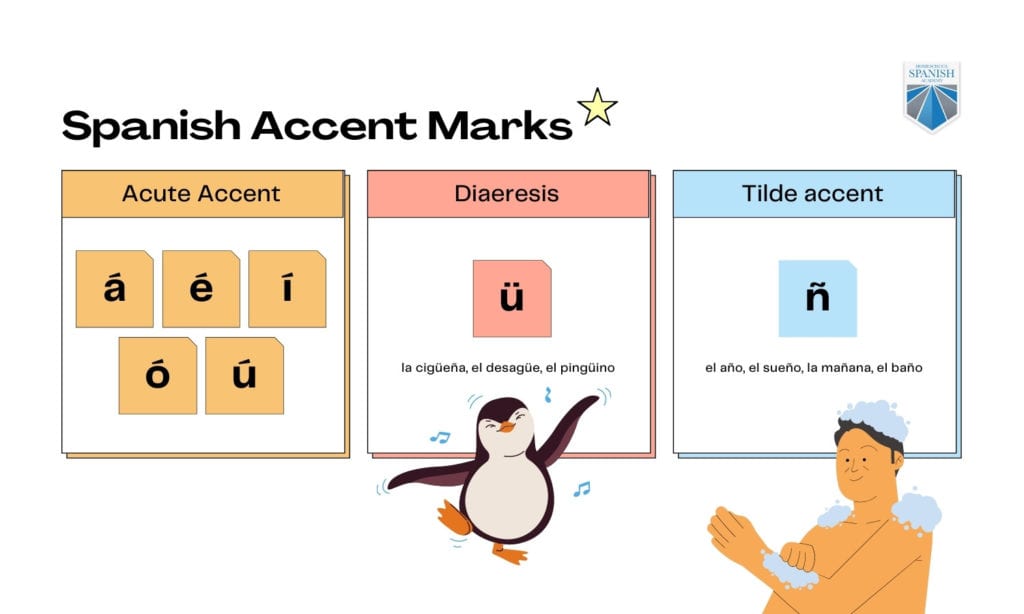
In Spanish, accent marks are essential, and they’re all around. You have names with accent marks, Spanish countries with accent marks, and words whose meaning changes simply due to an accent mark.
In this blog post, you’ll find answers to the following questions
Along with a handy set of rules for using Spanish accent marks, I’ll also show you exactly how to produce accents with your computer for writing in Spanish!
Accent marks, officially named “diacritics,” are these funny-looking visual marks placed above, below, or next to a letter to indicate pronunciation characteristics. They often change the tone, accent, stress, or meaning of a word.
The only English words with accent marks are borrowed from other languages. Prime examples are resumé, naÏve, or façade.
10 types of diacritic marks exist in all world languages, but luckily, there are only three Spanish marks you’ll need to learn!

The acute accent in Spanish (´) is the most complex Spanish accent mark in terms of rules—and it’s also the most common one.
The acute accent in Spanish can appear above all five vowels:
The acute accent in Spanish shows you which syllable in the word is stressed, specifically in cases where it’s marking an exception to normal Spanish stress rules.
Let me go into detail, as it’s essential to understand the stress rules in Spanish to know when and how to use the acute accent.
Word stress is a stronger, louder or longer pronunciation of a syllable in relation to other syllables in the same word.
In English, diacritics don’t exist to tell you which syllables are stressed—and the word stress does change the meaning!
Think about this:
What’s the meaning of the word project, with the stress on the first syllable?
It’s a type of plan, perhaps for school or to achieve a business goal.
But if I say project with the stress on the second syllable, what happens?
It’s meaning changes entirely—in fact it goes from being a noun to a verb and it means to estimate for the future or to cast something out, among other meanings.
Luckily, Spanish is easier in that its word stress rules are very clear.
But before we jump into which syllables to stress, let’s quickly cover how to separate the syllables in a word.
Interestingly, my experience as a Spanish teacher has shown me that breaking words into syllables seems to be easier for younger students than for teenagers or adults. Children simply rely on the help of clapping to divide the words instinctively, meanwhile older students seek to rely on rules.
So, let’s see some rules then!
1. When a consonant follows a vowel, it starts a new syllable:
However, if there are two vowels next to each other, we have to consider some scenarios. First, Spanish distinguishes between strong vowels (a, e, o) and weak vowels (i and u):
2. Two strong vowels together form two separate syllables:
3. A strong vowel and weak vowel combination as well as two weak vowels together make one syllable—this syllable is called a diphthong.

Knowing how to divide Spanish words into syllables is a fundamental skill that will help you to correctly apply the following rules on where to place stress in Spanish words.
1. Stress the second-to-last syllable if the word ends in a vowel, –n or -s.
2. Stress the last syllable if the word ends in a consonant different from –n or –s.
3. If the accented syllable defies the rules above, it requires an acute accent over the vowel in the stressed syllable. See the differences in meaning and pronunciation of words with and without an acute accent:
Let’s see the specific situations when you have to put on an acute accent.
There are four situations where the acute accent mark is required, and they all depend on the stressed syllable in the word.
1. If the word ends in a vowel, –n or -s and the stress is on the last syllable, it requires an acute accent:
2. If the word ends in a consonant or a vowel other than –n or -s, and the stress is on the second-to-last syllable, it requires an acute accent:
3. If the word stress is on the antepenultimate syllable (which comes just before the next to last), it requires an acute accent:
4. If the word stress is on the syllable before the antepenultimate, it requires the acute accent mark. This situation occurs when we add pronouns to gerunds, infinitives or imperatives.
As you continue your studies in Spanish, you quickly realize that there are no rules without exceptions!
That includes stress rules in relation to adverbs that end in -mente, which regularly have two stressed syllables.
The trick to identifying the proper location of word stress in Spanish adverbs is to mentally remove the –mente ending and then follow the acute accent rules of usage explained above—and to consistently put word stress on the -men- in -mente.
Sometimes, an acute accent exists solely for the purpose of distinguishing between homonyms, which are words that are written the same way but have a different meaning. An example of this is si (if) and sí (yes).
You won’t hear any difference in pronunciation, only in writing.
Here’s a list of common pairs of Spanish homonyms:
| Unaccented | Accented |
| de – of, from | dé – subjunctive form, 3rd. pers. sg of dar (to give) |
| el – the (masculine singular) | él – he |
| mas – but | más – more |
| mi – my | mí – me (object pronoun) |
| se – (reflexive pronoun) | sé – i know |
| si – if | sí – yes |
| te – you (object pronoun) | té – tea |
| tu – (your) | tú – you |
In addition to the rules above, all Spanish question words require an acute accent:
Learn more about Spanish interrogatives: Who, What, Where? Learn About Spanish Interrogatives
Now that you know how to use Spanish accent marks, it’s time to add them to your Spanish texts! While having a Spanish spell checker is a plus, you’ll want to know easy keyboard hacks for typing in Spanish.
Learning about Spanish accent marks means that you’re taking learning Spanish seriously. For many people, conversational skills are just enough, but caring about correct spelling and accent rules is stepping on a higher level.
Knowing not only how to speak Spanish but also how to write it can get you a salary raise or a totally new, dream job. According to a study by The Economist, your salary can grow considerably just by knowing a foreign language. And if you master the new language to the highest level, you can become an interpreter or translator, one of the fastest-growing occupations according to the Bureau of Labor Statistics.
How do you achieve your dream level of fluency? With practice, of course! Start today by signing up for a free class with one of our professional, native, Spanish-speaking teachers from Guatemala. Spend your free hour enhancing your usage of Spanish stress, understanding accents, and writing down tricky words.
Your learning journey grows one step at a time—and every step matters! Sign up today!

I'm a Spanish philologist, teacher, and freelance writer with a Master's degree in Humanities from Madrid. I speak Polish, Spanish, and English fluently, and want to get better in Portuguese and German. A lover of literature, and Mexican spicy cuisine, I've lived in Poland, Spain, and Mexico and I'm currently living and teaching in Madeira, Portugal.
Latest posts by Olga Put (see all)